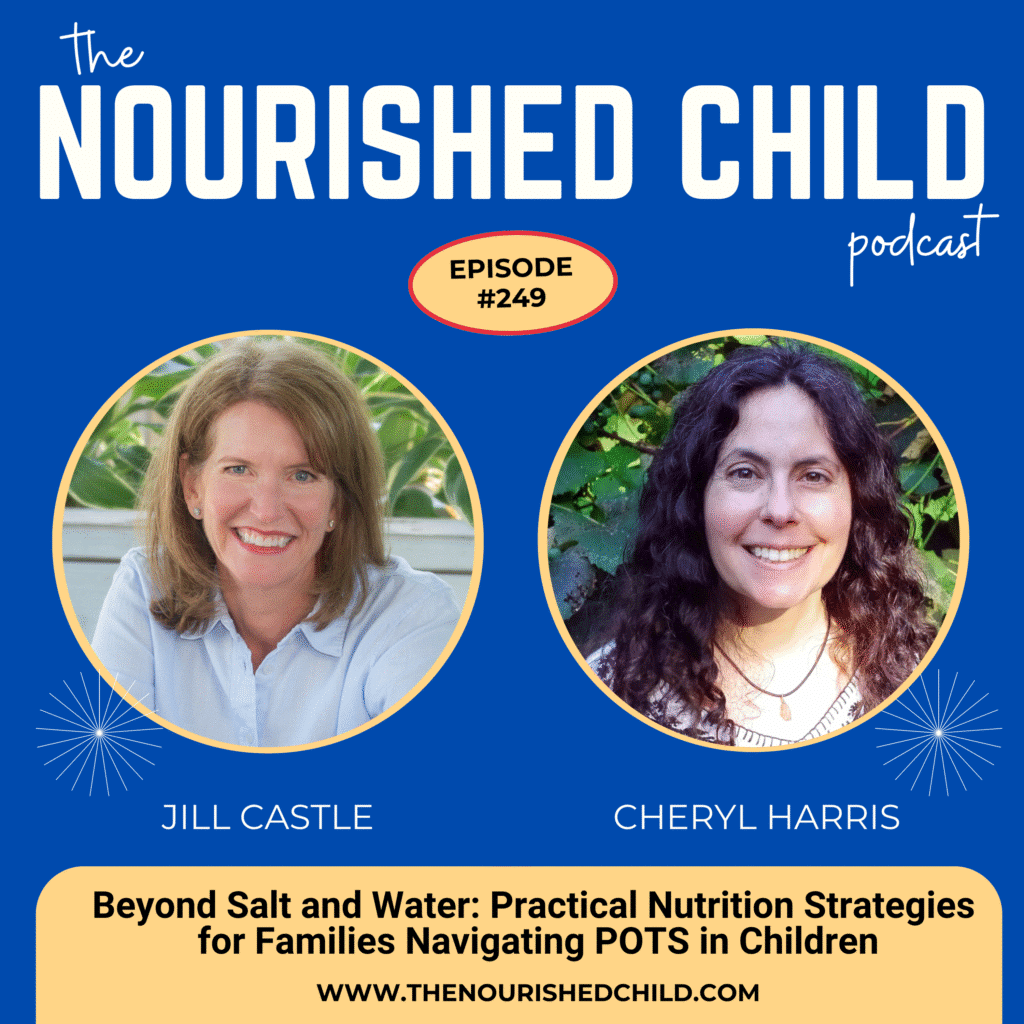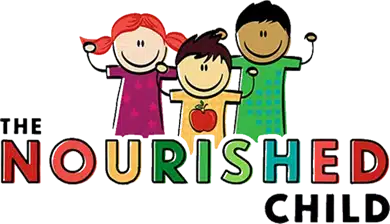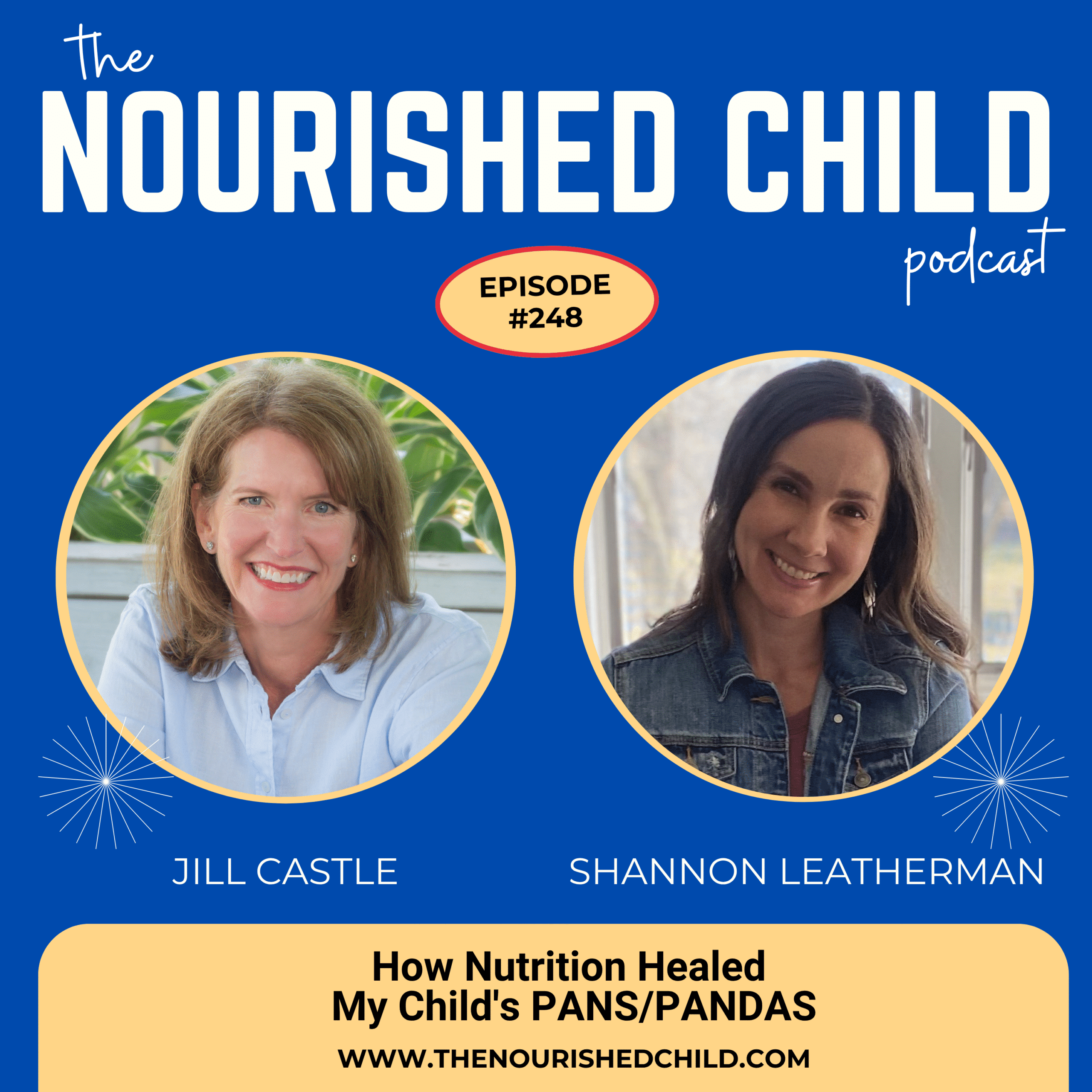Nutrition Strategies for POTS in Children (According to a Dietitian)
October 29, 2025
If your child has ever felt dizzy when standing up, unusually tired, or just “off” for reasons you can’t quite explain, you’re not alone.
These symptoms might point to something called Postural Orthostatic Tachycardia Syndrome (POTS) – a condition that’s often misunderstood and frequently missed in kids and teens.
In this episode of The Nourished Child® Podcast, I sat down with registered dietitian Cheryl Harris, an expert in digestive health and POTS, to talk about what this condition is, why it happens, and how nutrition and lifestyle can make a real difference.

What Is POTS?
POTS (Postural Orthostatic Tachycardia Syndrome) is a form of dysautonomia, meaning a dysfunction of the autonomic nervous system – the system that regulates heart rate, blood pressure, and digestion.
When a child with POTS stands up, their heart rate rises sharply because their blood volume doesn’t adequately reach the heart and brain. The result?
Lightheadedness, rapid heartbeat, fatigue, headaches, and sometimes gastrointestinal (GI) symptoms like nausea or constipation.
Most children with POTS are teen girls, often developing symptoms around puberty. Common triggers include viral infections, concussions, hormonal changes, and even high stress or trauma.
Common Symptoms of POTS in Children
- Dizziness or lightheadedness when standing
- Rapid heartbeat (tachycardia)
- Fatigue or brain fog
- Headaches
- Nausea, constipation, or diarrhea
- Exercise intolerance
- Feeling better when lying down
Because the symptoms overlap with other conditions – like dehydration, anxiety, or low iron – POTS can take time to diagnose. A simple home or in-office NASA Lean Test can help identify it by measuring heart rate changes from lying down to standing.
Why Nutrition Plays a Key Role
The foundation of managing POTS starts with fluid and electrolyte balance. Many kids with POTS have low blood volume, so the goal is to expand it.
1. Increase Fluids and Electrolytes
Children and teens with POTS often need 2–3 liters of fluids per day.
Electrolytes – especially sodium – help the body retain those fluids rather than flushing them out.
- Offer water, electrolyte drinks, broths, or smoothies.
- Encourage salty foods like pretzels, soups, or adding table salt to meals.
- Some children may need salt packets or oral rehydration solutions that follow the World Health Organization (WHO) formula, such as NormaLyte or DripDrop.
(Always check with your child’s healthcare provider for individualized recommendations.)
2. Mind the Gut: GI Issues and POTS
Up to 90% of people with POTS also experience gastrointestinal symptoms – constipation, diarrhea, reflux, or nausea. Sometimes these improve when hydration and salt intake are optimized.
A registered dietitian can help identify whether symptoms stem from irritable bowel syndrome (IBS), reflux, or delayed gastric emptying, and tailor the nutrition plan accordingly.
3. Be Aware of Disordered Eating Risks
Surprisingly, studies show that up to 75% of teens with POTS meet the criteria for disordered eating. This often stems from trying multiple diets to “feel better” or manage symptoms – not necessarily to lose weight.
Parents can help by:
- Focusing on balanced, flexible eating rather than food elimination.
- Avoiding unnecessary restrictive diets unless medically indicated.
- Working with an RD familiar with both POTS and eating disorders.
4. Foods That Support Recovery
There’s no single “POTS diet,” but most children benefit from:
- High-sodium foods: salted nuts, soups, olives, pickles.
- Hydrating foods: cucumbers, melons, oranges, tomatoes.
- Balanced meals: combining carbs, protein, and healthy fats to stabilize blood sugar.
- Low-glycemic meals: help sustain energy and prevent fatigue.
And while caffeine or alcohol can worsen dehydration, recumbent exercise – like swimming, Pilates, or a recumbent bike—can help improve circulation and strength over time.
5. When to Test for Celiac Disease
Interestingly, celiac disease appears in 4% of people with POTS, compared to 1% of the general population.
If your child has ongoing GI symptoms, fatigue, or nutrient deficiencies, it’s worth asking your pediatrician to screen for celiac disease before making major dietary changes like going gluten-free.
How Parents Can Support a Child with POTS
POTS can be overwhelming – for kids and parents alike. Beyond nutrition, emotional support and advocacy are crucial.
- Encourage your child to listen to their body.
- Help them communicate symptoms clearly to doctors and teachers.
- Ensure they stay hydrated throughout the day.
- Be patient – managing POTS is often a marathon, not a sprint.
As Cheryl Harris shared in our conversation:
“Even when teens act like they don’t need you, your presence, consistency, and support make all the difference.”
If your child has been diagnosed with POTS – or you suspect it – know that there are evidence-based ways to help them feel better. Nutrition, hydration, and gentle movement are powerful tools for managing symptoms and improving quality of life.
For more science-backed guidance on nourishing kids and teens, check out my book:
Fearless Feeding: How to Raise Healthy Eaters from High Chair to High School
Listen to the full conversation with Cheryl Harris on The Nourished Child® Podcast for expert insights, nutrition strategies, and practical guidance to help your child manage POTS and feel stronger, more energized, and supported every day.
Resources & Links
- Dysautonomia International
- NASA Lean Test: Patient Instructions (NHS Highland)
- NASA Lean Test: Clinician Instructions (Bateman Horne Center)
- Disordered Eating and POTS Study (PubMed)
- Gastrointestinal Symptoms and POTS Study (PubMed)
- Overview of POTS Nutrition (ScienceDirect)
- Cheryl’s Website: https://www.harriswholehealth.com
- Cheryl’s Publications: https://www.harriswholehealth.com/publications
- Cheryl’s Facebook: https://fb.com/HarrisWholeHealth

Jill Castle, MS, RD
I like empowering parents to help their children and teens thrive at every size with realistic advice centered on healthful habits around food, feeding, nutrition and health behaviors. As a pediatric dietitian and author, my goal is to share strategies and realistic advice to help you raise a healthy and happy child through my articles and podcast.



